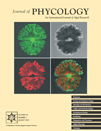EFFICIENCY OF GROWTH AND NUTRIENT UPTAKE FROM WASTEWATER BY HETEROTROPHIC, AUTOTROPHIC, AND MIXOTROPHIC CULTIVATION OF CHLORELLA VULGARIS IMMOBILIZED WITH AZOSPIRILLUM BRASILENSE1
Received 10 July 2009. Accepted 28 January 2010.
Abstract
Heterotrophic growth of microalgae presents significant economic advantages over the more common autotrophic cultivation. The efficiency of growth and nitrogen, phosphorus, and glucose uptake from synthetic wastewater was compared under heterotrophic, autotrophic, and mixotrophic regimes of Chlorella vulgaris Beij. immobilized in alginate beads, either alone or with the bacterium Azospirillum brasilense. Heterotrophic cultivation of C. vulgaris growing alone was superior to autotrophic cultivation. The added bacteria enhanced growth only under autotrophic and mixotrophic cultivations. Uptake of ammonium by the culture, yield of cells per ammonium unit, and total volumetric productivity of the culture were the highest under heterotrophic conditions when the microalga grew without the bacterium. Uptake of phosphate was higher under autotrophic conditions and similar under the other two regimes. Positive influence of the addition of A. brasilense was found only when light was supplied (autotrophic and mixotrophic), where affinity to phosphate and yield per phosphate unit were the highest under heterotrophic conditions. The pH of the culture was significantly reduced in all regimes where glucose was consumed, similarly in heterotrophic and mixotrophic cultures. It was concluded that the heterotrophic regime, using glucose, is superior to autotrophic and mixotrophic regimes for the uptake of ammonium and phosphate. Addition of A. brasilense positively affects the nutrient uptake only in the two regimes supplied with light.
Abbreviations:
-
- ANOVA
-
- analysis of variance
-
- MGPB
-
- microalgae growth-promoting bacteria
-
- OAB medium
-
- Okon, Albrecht, Burris medium
-
- SE
-
- standard error
-
- SGM
-
- synthetic wastewater medium
Autotrophic microalgae Chlorella spp. can grow heterotrophically (light independent) if supplemented with a preferred carbon source (Chen 1996, Shi et al. 2000, Lee 2004, Chen and Chen 2006, Qiao et al. 2009) or mixotrophically, that is, a combination of the two (Kaplan et al. 1986, Ogbonna et al. 1997, Lee 2004).
Chlorella spp. grown under autotrophic conditions can remove nitrogen and phosphorous from wastewaters under extremely diverse environmental conditions with efficiency of nitrogen removal generally higher than that of phosphorus (de la Noüe and de Pauw 1988, Gonzalez et al. 1997, de-Bashan et al. 2002b, 2008a, Olguín 2003, Hernandez et al. 2006); however, autotrophic tertiary wastewater treatment by Chlorella spp. poses two inherent major limitations. Wastewater is treated in large volumes in bioreactors where penetration of light into a dense culture is limited, a fact requiring large exposed surface area of the culture to light (Apt and Behrens 1999, Behrens 2005), and cultivation produces relatively low-cell densities in the wastewater culture (Lee 2001, Valderrama et al. 2002). Light-independent heterotrophic growth may solve these difficulties (Lee 2001, Chen and Chen 2006). It eliminates the need for light and may allow cultivation of denser concentrations of the microalgae (Chen 1996, Ogbonna et al. 1997). Singularly, elimination of light as a growth factor significantly reduces the cost of cultivation, the major parameter when large volumes of wastewater are treated (de la Noüe et al. 1992).
Heterotrophic growth of Chlorella spp. has been known for decades (Droop 1974) and is based on the addition of glucose, acetate, or glycerol as the main carbon sources; other carbon sources such as malate (Qiao et al. 2009) and several more were also evaluated. In some heterotrophic cultures, the growth rate of Chlorella, the dry biomass (Ogbonna et al. 2000, Behrens 2005), ATP generated by the supplied energy, and the effect on ATP yield (mg of biomass generated by mg of consumed ATP) are significantly higher than in autotrophic cultures (Martínez and Orús 1991, Chen and Johns 1996, Shi et al. 2000, Yang et al. 2000) and are mainly dependent on the species and strain used. Mixotrophic cultivation proved a good strategy to obtain high biomass and growth rates (Ogawa and Aiba 1981, Lee and Lee 2002) with the extra benefit of producing photosynthetic metabolites (Chen 1996).
Our working hypothesis for addressing a specific goal of potential wastewater treatment is that heterotrophic and mixotrophic cultivation of C. vulgaris are superior to autotrophic cultivation in terms of growth rate, affinity to the substrates, and the capacity of the developed high populations to uptake nutrients from wastewater. This has been carried out by employing a recently proposed technology for wastewater treatment (de-Bashan et al. 2004) and plant–bacteria interaction (de-Bashan and Bashan 2008), using a specific microalga immobilized with a bacterium that promotes growth in microalgae. We compared the growth rate and population size of the microalgae, its nitrogen and phosphorus uptake capacity from synthetic wastewater, and cultural factors, such as glucose consumption and pH shifts. This has been carried out under the three types of cultivation, where the sole difference was the energy supplied by light or glucose.
Materials and methods
Microorganisms and growth conditions. The unicellular microalga Chlorella vulgaris (UTEX 2714, Austin, TX) and the microalgae growth-promoting bacterium (MGPB) A. brasilense Cd (DMS 1843, Braunschweig, Germany) were tested. Experiments were carried out under autotrophic, heterotrophic, and mixotrophic conditions in inverted 1,000 mL conical glass bioreactors (17 cm tall, 14 cm width at top, and 5 cm at the bottom), each containing 750 mL synthetic wastewater, equipped with uplift bottom sterile aeration controlled by a peristaltic pump providing air at 30 mL air·min−1 measured with a fluxometer (GF-2000, Gilmont Instruments, Barrington, IL, USA) that pass three microbial filters: one 1 μm pore bacterial air vent filter (Pall-Gelman Laboratory, Ann Arbor, MI, USA) and two 0.2 μm sterile filters (Acrodiscs, Pall Corp., Ann Arbor, MI, USA). Each bioreactor was equipped with air outflow protected from contamination by a 0.2 μm filter and a glass tube exit at the bottom for taking wastewater samples. All experiments were performed in an environmental chamber (Biotronette Mark III, Lab-Line Instruments, Melrose Park, IL, USA) with fluorescent lamps. Heterotrophic cultivation in total darkness used the same environmental chamber, but the chamber was sealed. Autotrophic experiments were subjected to continuous fluorescent light at 90 μmol photon·m2·s−1 at 28 ± 1°C. Mixotrophic cultures were grown under a 12:12 light:dark (L:D) cycle. All microorganisms were cultivated in modified, sterile synthetic wastewater medium, hereafter called SGM (de-Bashan et al. 2002b), where ammonium and phosphate concentrations were adjusted to the concentrations found in municipal wastewater of the city of La Paz, Baja California Sur, Mexico (O. Perez-Garcia, Y. Bashan, and M. E. Puente, unpublished data). The synthetic wastewater at pH 6.7 contained the following ingredients (in mg·L−1): NaCl, 7; CaCl2, 4; MgSO4·7H2O, 2; K2HPO4, 21.7; KH2PO4, 8.5; Na2HPO4, 25; and NH4Cl, 191. The culture was stirred by continuous bubbling of sterile air. Heterotrophic and mixotrophic growth media were supplemented with a d-glucose solution at a concentration of 10 g·L−1. The glucose stock solution was sterilized by filtration through two 0.2 μm Whatman cellulose nitrate membranes (G.E. Healthcare, Piscataway, NJ, USA). The specific growth medium C30 for Chlorella sp. (Gonzalez et al. 1997), nutrient broth (Sigma, St. Louis, MO, USA), nitrogen-free OAB medium specific for Azospirillum sp. (Bashan et al. 1993), and saline solution (0.85% NaCl) was used to prepare the preinoculum for the experiments and as controls.
Cell counting and immobilization of microorganisms in alginate.
These procedures were performed according to the description in de-Bashan et al. (2004). Briefly, axenic cultures (either C. vulgaris or A. brasilense) were mixed with 2% alginate solution. Initial cell concentrations among experiments were similar: 1.0 ± 0.5 × 106 for C. vulgaris and 2.5 ± 0.5 × 105 for A. brasilense. Beads (2–3 mm in dia.) were automatically produced in a 2% CaCl2 solidification solution (de-Bashan and Bashan 2010). To immobilize the two microorganisms in the same bead, after washing the cultures, each was resuspended in 10 mL 0.85% saline solution and then mixed together with the alginate. Because immobilization normally reduces the number of Azospirillum cells in the beads, a second overnight incubation of the beads in diluted (10% of full strength) nutrient broth was necessary. Each bioreactor contained 30 g of beads.
 (1)
(1)Analytical methods. Nitrogen and phosphorus were analyzed from 5 mL samples obtained from the bottom exit of each bioreactor, using standard water analysis techniques (Eaton et al. 2005). Orthophosphate was measured by molybdate assay carried out in an analyzer (Flow Injection Analysis, Lachat QuikChem series 8000 FIAS+, Loveland, CO, USA) according to the manufacturer’s manual. Ammonium was measured by the phenate colorimetric method (Solorzano 1969) and adapted to the microplate (Versa Max tunable microplate reader, Molecular Devices, Sunnyvale, CA, USA) (Hernández-López and Vargas-Albores 2003). Glucose was analyzed by the glucose oxidase-peroxidase (GOD-PAP) method using a kit (Randox Laboratories, Crumlin, UK) according to the manufacturer’s manual. The pH was measured by a pH-electrode (Horiba-twin pH, Irvine, CA, USA).
 (2)
(2) (3)
(3) (4)
(4)Results
Autotrophic, heterotrophic, and mixotrophic growth of C. vulgaris in synthetic wastewater alone and jointly immobilized with A. brasilense. In the absence of light and a carbon source (control treatment), very slow growth of C. vulgaris occurred (Fig. 1a, lowercase letter analysis and μ calculation) with small, but significant enhancing effect of immobilization with the MGPB A. brasilense Cd starting after 3 d of cultivation (Fig. 1a, capital letter analysis).
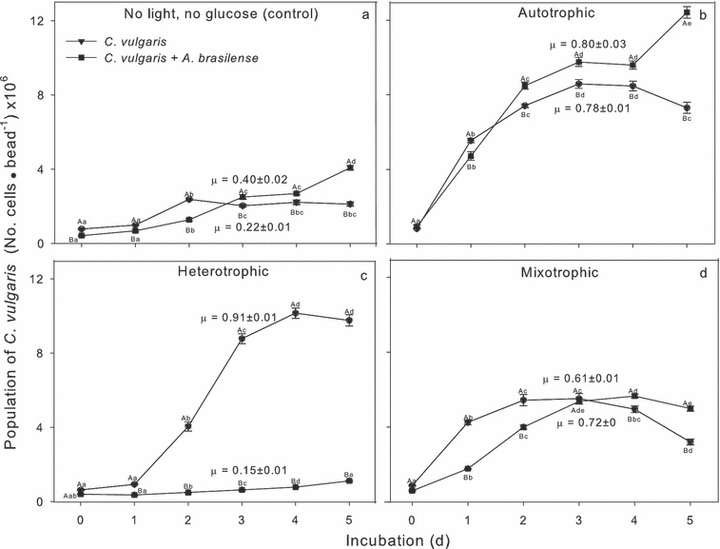
Populations of immobilized Chlorella vulgaris alone and jointly immobilized with Azospirillum brasilense growing under autotrophic, heterotrophic, and mixotrophic growth conditions in synthetic wastewater. Values of each curve denoted with a different lowercase letter differ significantly by two-way analysis of variance (ANOVA) and by Tukey’s post hoc analysis at P < 0.05. Values at each date denoted with a different capital letter differ significantly by Student’s t-test at P < 0.05. Bars represent standard error of the mean (SE). Absence of a bar indicates negligible SE. μ represents growth rate.
Application of light significantly enhanced growth (Fig. 1b, lowercase letter analysis and μ calculation), followed the same trend as joint immobilization, but started a day earlier (Fig. 1b, capital letter analysis). Growing alone, C. vulgaris reached the stationary phase after 3 d, while jointly immobilized with the MGPB steadily increased population numbers up to 5 d (Fig. 1b, lowercase letter analysis).
Under heterotrophic growth, C. vulgaris grown alone had slightly larger populations and had higher growth rates than under autotrophic growth (compare Fig. 1, b and c), while joint immobilization significantly inhibited microalgal growth (Fig. 1c, both types of analysis and μ calculation).
Mixotrophic growth yielded intermediate populations and lower growth rates compared to autotrophic and heterotrophic growth, reached stationary phase after 2 d for the microalga grown alone (Fig. 1d, lowercase letter analysis and μ calculation), and was declining after 4 d of cultivation, while joint immobilization prevented population decline but did not enhance growth further (Fig. 1d, capital letter analysis).
Analysis of growth showed that 3 d of incubation is the important time for most cultures, indicating that heterotrophic growth was similar to autotrophic growth, while joint immobilization enhanced growth only under autotrophic conditions, with lesser enhancement also in the control (no light and no glucose).
Autotrophic, heterotrophic, and mixotrophic growth of A. brasilense grown alone in synthetic wastewater and jointly immobilized with C. vulgaris. No growth of A. brasilense occurred in wastewater without a carbon source, with or without C. vulgaris (Fig. 2a). Under autotrophic conditions, A. brasilense grew only in the presence of C. vulgaris for 3 d, and then growth declined (Fig. 2b). Under heterotrophic conditions, A. brasilense grew for 2 d, but later growth ceased (Fig. 2c, lowercase letter analysis). When the bacteria were jointly immobilized with C. vulgaris, the bacteria grew linearly, producing significantly larger populations (Fig. 2c, capital letter analysis and linear regression analysis). Under mixotrophic conditions, the bacteria grew for 2 d (jointly immobilized) and 3 d (alone), but then entered the stationary phase in both treatments (Fig. 2d, lowercase letter analyses). Joint immobilization had, in general, no effect on the growth of A. brasilense (Fig. 2d, capital letter analysis).
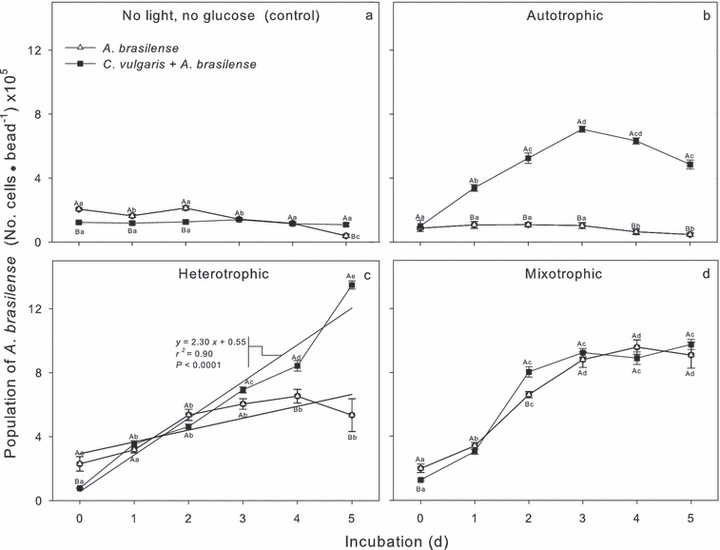
Populations of immobilized Azospirillum brasilense alone and jointly immobilized with Chlorella vulgaris growing under autotrophic, heterotrophic, and mixotrophic growth conditions in synthetic wastewater. Values of each curve denoted with a different lowercase letter differ significantly by two-way analysis of variance (ANOVA) and by Tukey’s post hoc analysis at P < 0.05. Values at each date denoted with a different capital letter differ significantly by Student’s t-test at P < 0.05. Bars represent standard error of the mean (SE). Absence of a bar indicates negligible SE. Linear regression under heterotrophic growth is for the joint immobilization treatment.
Uptake of ammonium under autotrophic, heterotrophic, and mixotrophic growth conditions. Without light and a carbon source, controls of alginate beads and beads containing A. brasilense did not remove ammonium from wastewater similar to wastewater incubated without any treatment (Fig. 3a, lowercase letter analysis). Under these conditions, C. vulgaris immobilized alone uptakes a small, but statistically significant, amount of ammonium for only 1 d, and later the uptake ceased (Fig. 3a, lowercase letter analysis). Jointly immobilized microorganisms could uptake more ammonium for only 2 d (Fig. 3a, capital letter analysis) before uptake ceased (Fig. 3a, lowercase letter analysis). Although the statistical analysis indicated significant ammonium uptake, in several cases, <20% of ammonium was taken up in the best cases after 3 d of incubation (Fig. 3e).
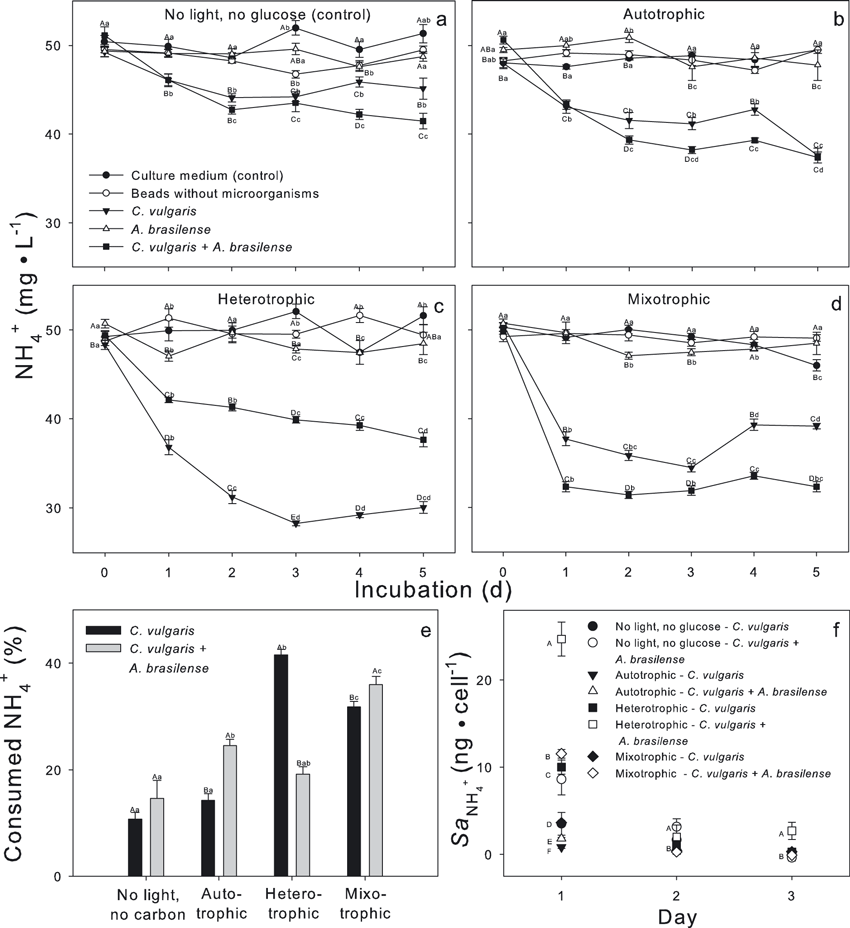
Ammonium uptake (a–d), ammonium consumed (e) on the third day of incubation, and affinity for ammonium (f) of Chlorella vulgaris alone and jointly immobilized with Azospirillum brasilense growing under autotrophic, heterotrophic, and mixotrophic growth conditions in synthetic wastewater. All statistical analyses were performed using two-way analysis of variance (ANOVA) combined with Tukey’s post hoc analysis or by Student’s t-test both at P < 0.05 as follows: In (a–d), values on each curve denoted with a different lowercase letter differ significantly by ANOVA. Values at each date denoted with a different capital letter differ significantly by ANOVA. In (e), columns of C. vulgaris alone or jointly immobilized with A. brasilense separately denoted with a different lowercase letter differ significantly by ANOVA. Pairs of columns at each treatment type denoted with a different capital letter differ significantly by Student’s t-test. In (f), values corresponding to each day separately denoted with a different capital letter differ significantly with ANOVA. Bars represent standard error of the mean (SE). Absence of a bar indicates negligible SE.
Autotrophic, heterotrophic, and mixotrophic growth conditions did not induce ammonium uptake in the two control treatments or treatment with Azospirillum (Fig. 3, b, c, and d, lowercase letter analyses). Under autotrophic conditions, treatment with immobilized C. vulgaris increased ammonium uptake, and jointly immobilized microorganisms enhanced it further for up to 2 d of incubation (Fig. 3b, capital letter analysis) where these treatments removed <30% of the ammonium (Fig. 3e).
Under heterotrophic growth conditions, ammonium uptake was further enhanced by C. vulgaris immobilized alone for 3 d, reached 44% removal, and then stabilized (Fig. 3c, lowercase letter analysis, and Fig. 3e). Joint immobilization continuously took up ammonium for 4 d, but at lower levels, reaching a maximum uptake of 22% after 3 d of incubation. Uptake of ammonium under mixotrophic conditions was somewhat similar to uptake under heterotrophic conditions, where joint immobilization was the more efficient treatment (Fig. 3, d and e).
At the cellular level, a different ammonium uptake profile occurred when the affinity of the cells to the substrate was calculated, and this affinity varied with time. After 1 d of incubation under heterotrophic conditions, jointly immobilized microorganisms had significantly higher affinity, compared to all treatments followed by joint immobilization under mixotrophic conditions (Fig. 3f). Later, even though joint immobilization was superior, differences with the other treatments were small (Fig. 3f, days 1 and 2).
Uptake of phosphate under autotrophic, heterotrophic, and mixotrophic growth conditions. Without light and a carbon source, all controls and treatments took up small quantities of phosphate to a level of up to 15.7% after 3 d of incubation, where the treatments of C. vulgaris immobilized alone removed the most (Fig. 4, a and e). Although statistical differences among the treatments were detected in most sampling times (Fig. 4a, capital letter analysis), quantities were small. Under autotrophic, heterotrophic, and mixotrophic conditions, both controls and beads with A. brasilense took up meager amounts of phosphate or none at all in some samplings (Fig. 4, b–d), while C. vulgaris alone removed up to 20.8% (autotrophic), 17.8% (heterotrophic), and 20.9% (mixotrophic) after 5 d (Fig. 4c). When jointly immobilized with A. brasilense, uptake increased to 31.5% (autotrophic), 22.6% (heterotrophic), and 24.3% (mixotrophic) after 5 d of incubation (Fig. 4b). The most rapid uptake was in the first 2 d under light conditions (autotrophic and mixotrophic conditions) (Fig. 4, b and e). Under heterotrophic conditions, similar quantities of uptake by C. vulgaris alone and jointly immobilized with A. brasilense occurred for the first 4 d of incubation with an increase in uptake by C. vulgaris alone after 5 d (Fig. 4, c and e). Similar removal was measured under mixotrophic conditions, where the C. vulgaris immobilized with A. brasilense performed better and most of the uptake occurred in the first day (Fig. 4, d and e). Affinity of individual cells for phosphate after 1 d followed a similar trend, where jointly immobilized cells under heterotrophic conditions had the highest affinity, followed by the same treatment under mixotrophic conditions (Fig. 4f). The superior affinity of heterotrophic, joint immobilization lasted, at a reduced rate, for an additional day, diminishing afterward (Fig. 4f).
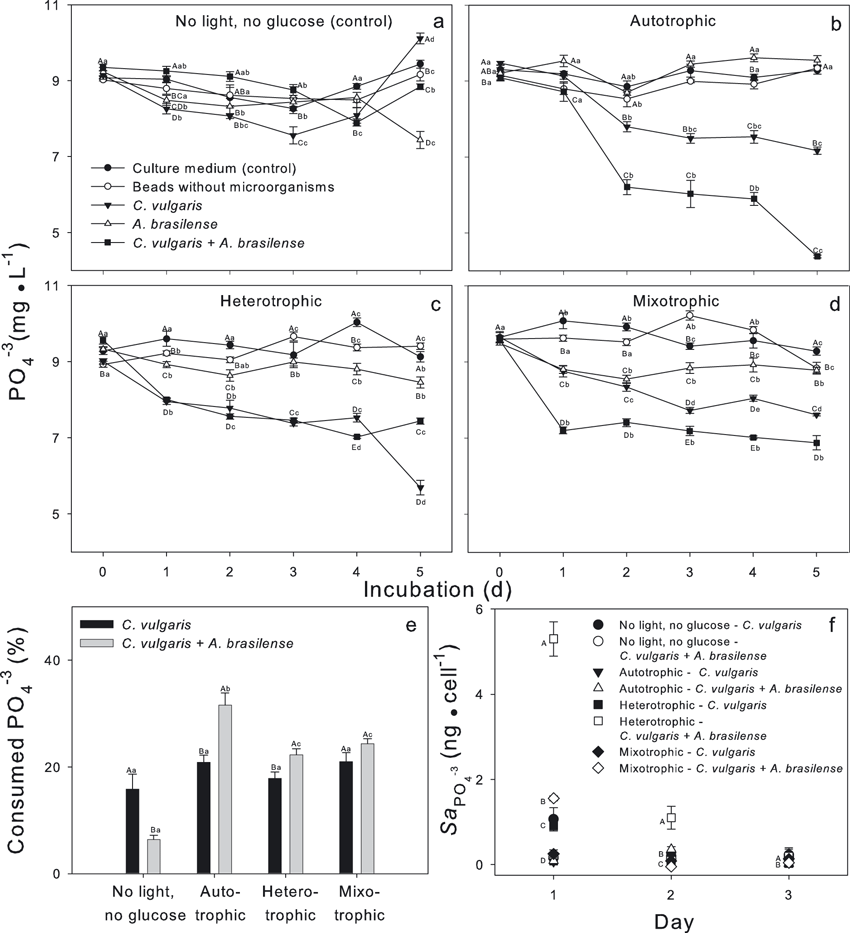
Phosphate uptake (a–d), phosphate consumed at the third day of incubation (e), and affinity for phosphate (f) of Chlorella vulgaris alone and jointly immobilized with Azospirillum brasilense growing under autotrophic, heterotrophic, and mixotrophic growth conditions in synthetic wastewater. All statistical analyses used two-way analysis of variance (ANOVA) combined with Tukey’s post hoc analysis or by Student’s t-test both at P < 0.05 as follows: In (a–d), values on each curves denoted with a different lowercase letter differ significantly by ANOVA. Values at each date denoted with a different capital letter differ significantly by ANOVA. In (e), columns of C. vulgaris alone or jointly immobilized with A. brasilense separately denoted with a different lowercase letter differ significantly by ANOVA. Pairs of columns at each treatment type denoted with a different capital letter differ significantly by Student’s t-test. In (f), values corresponding to each day separately denoted with a different capital letter differ significantly by ANOVA. Bars represent standard error of the mean (SE). Absence of a bar indicates negligible SE. Some statistics letters were eliminated for clarity.
Consumption of glucose under different conditions of incubation. Glucose was added only to cultures growing under heterotrophic and mixotrophic conditions. Under those conditions, both controls and beads with A. brasilense did not consume or remove significant amounts of glucose from the medium (Fig. 5, a and b, lowercase letter analysis). C. vulgaris alone under both growth conditions consumed glucose at the end of the incubation period, up to 18.6% under heterotrophic and up to 23.7% under mixotrophic conditions (Fig. 5, a and b). Joint immobilization enhances consumption of glucose during the first 2 d, but this level of consumption was not maintained (Fig. 5, a and b).
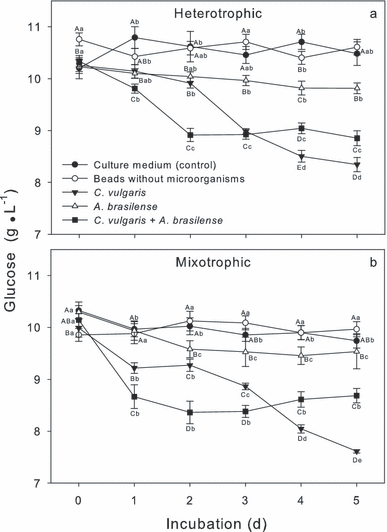
Glucose uptake of Chlorella vulgaris alone and jointly immobilized with Azospirillum brasilense growing under heterotrophic and mixotrophic growth conditions in synthetic wastewater. Values of each curve denoted with a different lowercase letter differ significantly by two-way analysis of variance (ANOVA) and by Tukey’s post hoc analysis. Values at each date denoted with a different capital letter differ significantly by ANOVA, all at P < 0.05. Bars represent standard error of the mean (SE).
Changes in the pH under different conditions of incubation. In the absence of light and a carbon source, the pH did not change with time for any treatment (Fig. 6a). Under autotrophic conditions, C. vulgaris alone or jointly immobilized with A. brasilense significantly and similarly reduced the pH to <5 (Fig. 6b). Under heterotrophic conditions, significant reduction in the pH of both treatments was recorded (Fig. 6c, lowercase letter analysis), where joint immobilization reduced it faster in the first 3 d (Fig. 6c, capital letter analysis), but the level was similar to C. vulgaris alone afterward. Under mixotrophic conditions, similar phenomena occurred, with the single difference that C. vulgaris alone lowered the pH faster than a culture with jointly immobilized microorganisms (Fig. 6d).
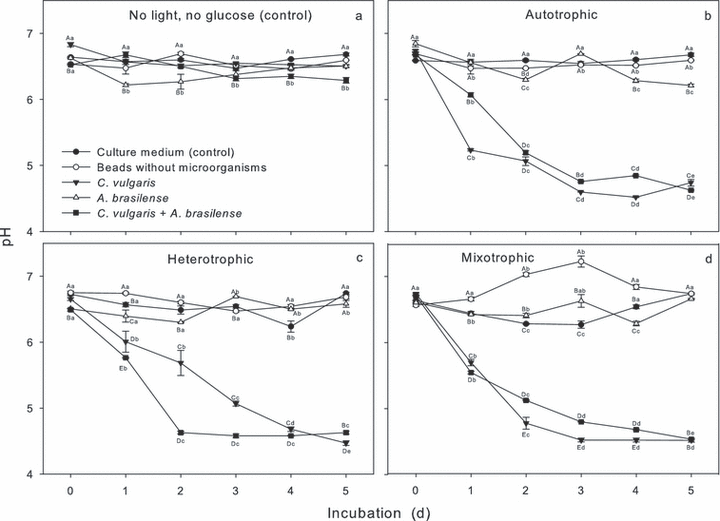
Changes in the pH during cultivation of Chlorella vulgaris alone and jointly immobilized with Azospirillum brasilense growing under autotrophic, heterotrophic, and mixotrophic growth conditions in synthetic wastewater. Values of each curve denoted with a different lowercase letter differ significantly by two-way analysis of variance (ANOVA) and by Tukey’s post hoc analysis at P < 0.05. Values at each date denoted with a different capital letter differ significantly by ANOVA, all at P < 0.05. Bars represent standard error of the mean (SE). Absence of a bar indicates negligible SE.
Productivity of the three incubation regimes. The number of cells grown per mg of ammonium per liter of culture after 3 d of incubation was the highest under autotrophic growth; the other treatments had no significant effect (Fig. 7a, lowercase letter analysis). Jointly immobilized microalga and bacteria under autotrophic and heterotrophic conditions produced significantly fewer cells for the quantity of ammonium consumed, where no effect occurred under mixotrophic and control conditions (Fig. 7a, capital letter analysis).
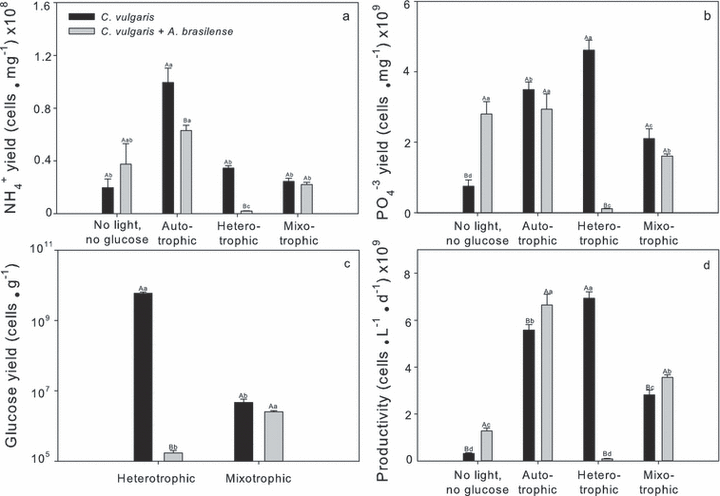
(a–c) Yield (number of cells produced per mg substrate uptake in 1 L of culture during the first 3 d of incubation) of Chlorella vulgaris alone and jointly immobilized with Azospirillum brasilense growing under autotrophic, heterotrophic, and mixotrophic growth conditions in synthetic wastewater. (a) Ammonium, (b) phosphate, (c) glucose, and (d) volumetric productivity of all immobilized and jointly immobilized systems. In each panel, columns of C. vulgaris alone or jointly immobilized with A. brasilense separately denoted with a different lowercase letter differ significantly by two-way analysis of variance (ANOVA) and by Tukey’s post hoc analysis. Pairs of columns of each treatment type denoted with a different capital letter differ significantly by Student’s t-test, all at P < 0.05.
C. vulgaris immobilized alone under heterotrophic conditions had the highest yield for phosphate consumed, and the autotrophic and mixotrophic growth was less (Fig. 7b, lowercase letter analysis). Immobilization of the bacterium reduced the yield (heterotrophic condition) or had no effect (autotrophic and mixotrophic conditions). Only under the conditions of the control did joint immobilization have a significant effect on using phosphate (Fig. 7b, capital letter analysis).
C. vulgaris immobilized alone under heterotrophic conditions had the highest yield per glucose consumed; mixotrophic growth was less efficient (Fig. 7c, lowercase letter analysis). Immobilization under heterotrophic conditions had a negative impact on glucose yield and had no effect under mixotrophic conditions (Fig. 7c, capital letter analysis).
Volumetric productivity per liter of culture of the three systems indicates that microalga immobilized alone under heterotrophic conditions had the best performance, followed by autotrophic and the mixotrophic (Fig. 7d, lowercase letter analysis). Joint immobilization with the bacterium enhanced total volumetric productivity under autotrophic and mixotrophic conditions, but not under heterotrophic conditions (Fig. 7d, capital letter analysis); under autotrophic conditions, p volumetric productivity of jointly immobilized cultures was as high as under heterotrophic cultures solely of C. vulgaris.
Discussion
Most applications of microalgae use light because microalgae are very efficient solar energy converters, and they can produce a great variety of useful metabolites autotrophically (Lebeau and Robert 2006). Yet, light-independent heterotrophic growth, wherever possible, has significant economic advantage over light-dependent growth in mass-producing microalgae (Chaumont 1993, Borowitzka 1999). So far, because of the high volume of wastewater, autotrophic tertiary nutrient removal is uncommon (de-Bashan and Bashan 2004, Muñoz and Guieysse 2006).
Despite the economic incentive, heterotrophic growth in wastewater treatment has inherent major limitations. Those included (a) low tolerance to high carbon concentrations; (b) competition with other bacteria and yeasts that have enhanced growth in heterotrophic, nonaxenic wastewater and that have shorter generation times than the microalgae; (c) not all species of microalgae can grow without light (Lee 2001); and (d) some organic compounds inhibit microalgal growth (Chen 1996). As an initial step for evaluating the potential of different cultivation systems for wastewater treatment, this study used a defined synthetic wastewater in small laboratory bioreactors and a common strain of C. vulgaris, previously shown to be an efficient wastewater treatment agent (de-Bashan et al. 2002b, 2004) and capable of growing heterotrophically on municipal wastewater supplemented either with glucose or Na-acetate (O. Perez-Garcia, Y. Bashan, M. E. Puente, unpublished data). Glucose is known to support heterotrophic growth of several Chlorella sp., including C. vulgaris (Lee 2004).
Heterotrophic cultivation of C. vulgaris was superior to autotrophic and mixotrophic growth, although each cultivation scheme has its advantages under specific conditions, depending on the end goal of cultivation: biomass or nutrient uptake. The highest ammonium uptake (36%) occurred in heterotrophic cultivation when the culture was loaded with a high concentration of ammonium, higher than under autotrophic cultivation. This uptake by the entire heterotrophic culture contrasts with the superiority of autotrophic cultivation in terms of the amount of growing cells, biomass produced, growth rate, and the yield of cells per quantity of ammonium consumed. Although even higher percentage uptakes of ammonium were previously recorded using this immobilization system and this strain under autotrophic conditions (de-Bashan et al. 2002b, 2004), those were performed in a far lower initial ammonium concentration (<10 vs. 50 mg·L−1 in this study). Consequently, in a total quantity of ammonium uptake, the heterotrophic regime is superior to the recorded level.
A plausible explanation for these results might be found in a combination of high affinity of cells for ammonium, and their high growth rate in heterotrophic cultivation of C. vulgaris, used alone, was far superior to other treatments and culture conditions. It appears that under heterotrophic conditions, cells that are growing alone uptake large quantities of ammonium and use it for cell multiplication. However, when these cells, jointly immobilized with A. brasilense, are used for ammonium uptake, it is not used for multiplication, but possibly stored, as in cell cultures of higher plants growing in the dark and using glucose nutrition (Buchanan et al. 2000). The reason that heterotrophic cultures of C. vulgaris growing alone uptake more ammonium than cultures that are jointly immobilized with A. brasilense is because of the higher growth rate. Consequently, larger populations form, and this is not related to the high affinity of the cells for ammonium. Under mixotrophic conditions, cultures of C. vulgaris (alone or with A. brasilense) take up more ammonium than cultures under autotrophic conditions because of higher affinity for ammonium under these conditions. Higher affinity for ammonium in heterotrophic and mixotrophic cultures occurs because more ATP and NAD(P)H for metabolic processes is available, which is unrelated to autotrophic carbon assimilation (Calvin cycle) (Yang et al. 2000), such as for primary nitrogen assimilation by the enzymes of the nitrogen cycle in Chlorella spp. The difference between the Sa values for nitrogen and phosphorus (discussed later) might be explained because during the first day of sampling the largest uptake of both nutrients occurred with the smallest population of microalgae, compared to later samplings, where the population was larger but removal of the nutrients did not significantly increase or increased only to a small extent.
The presence of the MGPB A. brasilense enhanced ammonium and phosphate uptake by the microalgae when light was provided under autotrophic and mixotrophic conditions (de-Bashan et al. 2002b, 2004, 2008c), but not under heterotrophic conditions. This occurred because the “helper” bacterium enhanced, in general, the growth rate of the microalgae (Gonzalez and Bashan 2000, de-Bashan et al. 2008a, this study) by affecting photosynthesis patterns. The specific role of Azospirillum had been shown by producing phytohormones and affecting several cellular metabolisms of the microalga (de-Bashan et al. 2002a, 2008a). So far, previous studies have shown that its role in removing nutrients is minimal (de-Bashan et al. 2002b, 2004). Furthermore, the two microorganisms significantly differ in individual cell size and their final population size in culture. We showed that microalgal populations are at least one order of magnitude larger than those of the MGPB. While these microalgal populations are common for this species (Gonzalez and Bashan 2000), the levels of the bacterial population for this bacterial species are small (Bashan et al. 2004). This happened because the medium suitable for the microalga is less suitable for the growth of A. brasilense. Although A. brasilense can use ammonium for growth (Van Dommelen et al. 1997), the relatively small populations of A. brasilense in a jointly immobilized system removed only minute amounts of nitrogen and phosphate from wastewater (de-Bashan et al. 2002b, this study) or may live also on exudates from the microalgae (Watanabe et al. 2006).
Under heterotrophic cultivation, joint immobilization significantly increased the affinity of C. vulgaris to ammonium and phosphate, compared to other treatments, but did not increase the population. The yield, a value composed of the number of cells per substrate (either ammonium or phosphate), is very low. All of these findings indicate that the cells are metabolically active but do not use these nutrients for multiplication. Our experimental evidence supports the claim by de-Bashan et al. (2005, 2008b) that the effect of the “helper” bacterium is to increase ammonium consumption of each cell and not that the elimination of ammonium is a result of increase in the size of the population.
Removal of phosphate is far less affected by the different treatments, where autotrophic cultivation was the best one and adding the MGPB into autotrophic, heterotrophic, and mixotrophic conditions enhanced this ability, similar to previous studies on that topic (Hernandez et al. 2006). Differences in rates of removal between the regimes are not a consequence of the affinity of the cells for phosphate. In spite of the higher affinity in mixotrophic and heterotrophic cultures for phosphate, removal in autotrophic cultures was significantly superior. Superiority of C. vulgaris jointly immobilized with A. brasilense under autotrophic conditions could be explained by accumulation of phosphorus as polyphosphates (Hernandez et al. 2006) and/or a higher efficiency in metabolizing inorganic phosphorus to ATP via photo and oxidative phosphorylation (Yang et al. 2000).
Regardless of the cultivation conditions and because of the use of ammonium as the sole nitrogen source, the pH of the culture always declined to low values because consumption of ammonium releases protons and the decreased pH impairs cultivation (Kaplan et al. 1986, Grobbelaar 2004, this study). When C. vulgaris grew on high concentrations of ammonium, the pH of the culture dropped as long as ammonium was present, even if the pH was adjusted daily (Tam and Wang 1996). All these factors imply that, in these cultures, there is no loss of ammonium via volatilization, because ammonium is converted to volatile ammonia only at pH > 8.5. Joint immobilization with A. brasilense reduced the negative effects of pH shifts, but at higher pH levels than the ones present in this study (de-Bashan et al. 2005).
A general evaluation of the various growing regimes and immobilization parameters explored in this study (Table 1) showed that heterotrophic cultivation of C. vulgaris yielded the highest uptake of ammonium from synthetic wastewater compared to autotrophic and mixotrophic growth. Heterotrophic cultivation did not enhance uptake of phosphate, compared to the other treatments. Adding the MGPB to the culture had positive effects only for autotrophic cultivations (high ammonium and phosphate removal and high cell populations of C. vulgaris), but not for heterotrophic and mixotrophic cultures.
| Parameter | Per specific growth conditions | Comparison among all growth conditions |
|---|---|---|
| Chlorella growth | Control – jointly immobilizedAutotrophic – jointly immobilizedHeterotrophic –Chlorella aloneMixotrophic – jointly immobilized | Heterotrophic –Chlorella alone |
| Azospirillum growth | Control – similarAutotrophic – jointly immobilizedHeterotrophic – jointly immobilizedMixotrophic – similar | Heterotrophic – jointly immobilized |
| Ammonium consumption | Control – jointly immobilizedAutotrophic – jointly immobilizedHeterotrophic –Chlorella aloneMixotrophic – jointly immobilized | Heterotrophic –Chlorella alone |
| Affinity for ammonium | Not applicable | Heterotrophic – jointly immobilized |
| Phosphate consumption | Control –Chlorella aloneAutotrophic – jointly immobilizedHeterotrophic – jointly immobilizedMixotrophic – similar | Autotrophic – jointly immobilized |
| Affinity for phosphate | Not applicable | Heterotrophic – jointly immobilized |
| Glucose consumption | Heterotrophic – jointly immobilizedMixotrophic – jointly immobilized | Similar |
| Ammonium yield | Control – similarAutotrophic –Chlorella aloneHeterotrophic –Chlorella aloneMixotrophic – similar | Autotrophic –Chlorella alone |
| Phosphate yield | Control – jointly immobilizedAutotrophic – similarHeterotrophic –Chlorella aloneMixotrophic – similar | Heterotrophic –Chlorella alone |
| Glucose yield | Heterotrophic –Chlorella aloneMixotrophic – similar | Heterotrophic –Chlorella alone |
| Volumetric productivity | Control – jointly immobilizedAutotrophic – jointly immobilizedHeterotrophic –Chlorella aloneMixotrophic – jointly immobilized | Autotrophic – jointly immobilizedHeterotrophic –Chlorella alone |
- Similar: treatment of Chlorella alone = treatment of jointly immobilized with A. brasilense.
Acknowledgments
We thank the following personnel of CIBNOR: Iban Murillo (phosphate analysis), Jorge Cobos (bioreactor manufacturing), Roberto Hernandez (glucose analysis), and Esther Puente (advice concerning microbiological techniques). This study was mainly supported by Consejo Nacional de Ciencia y Tecnología (CONACYT contract 23917), Secretaria de Medio Ambiente y Recursos Naturales (SEMARNAT contract 23510), and time for writing by the Bashan Foundation, USA. O. P.-G. is a recipient of a fellowship from CONACYT (contract 207021) with additional funding from SEMARNAT and the Bashan Foundation.



